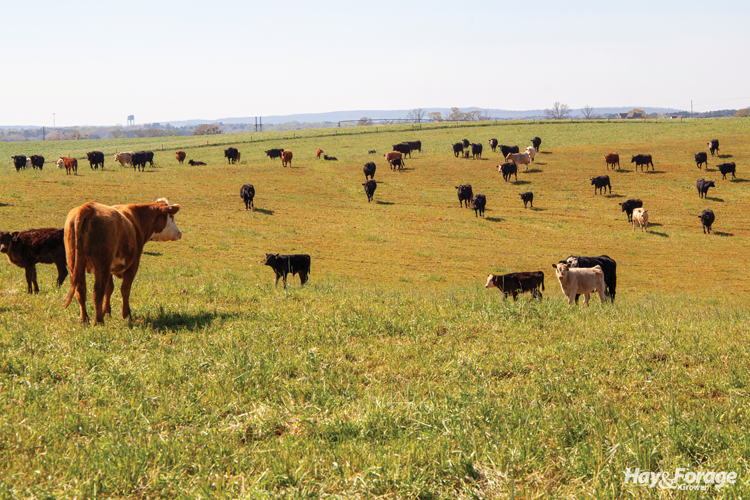Overgrazing versus overstocking |
| By Jim Gerrish |
|
|
|
The author is a rancher, author, speaker, and consultant with over 40 years of experience in grazing management research, outreach, and practice. He has lived and grazed livestock in hot, humid Missouri and cold, dry Idaho.  I hear people talk about overgrazing in a lot of different settings. They see a pasture that has been grazed shorter than what they believe is appropriate, and they are quick to label it as overgrazing. More often than not, what they are seeing is severe grazing. Other times I hear people talk about a pasture being overstocked. Are they the same thing? No, they are not. Overstocking is having more livestock or grazing pressure than the pasture can support. This is a problem of having too many animals. Does overgrazing occur when a pasture is overstocked? Yes, it does, and the only way to cost-effectively address the problem is by reducing stock numbers. Sometimes a livestock producer will try to address overstocking by buying additional feed. That will only work when feed prices are low and cattle prices are high. That doesn’t happen frequently, so we usually need to address overstocking by reducing the number of livestock on the pasture. Can overgrazing occur on an understocked or even an appropriately stocked farm or ranch? Yes, it can. That is because overgrazing is a failure of effective time management and is not necessarily related to having too many head of livestock on the land. Overstocking is a ranch-wide problem that can only be addressed through reducing stock numbers or expanding the land base. Overgrazing, on the other hand, happens one plant at a time and needs to be addressed by changing time management. More than one way Overgrazing results in a plant being put into a state of negative carbohydrate balance. In this condition, a plant requires more energy than active photosynthesis can provide and forces it to draw on stored energy reserves. There are two avenues to overgrazing. The first is when animals remain too long on a pasture and they are grazing off regrowth being fueled by stored energy. This grazing practice will deplete the stored energy of the plant and can weaken the plant to the point that it will die. This type of overgrazing often occurs to the most desirable plants and frequently is the result of grazing at a low stock density, which allows for a high degree of selective grazing. The second avenue is when we remove livestock from a pasture and allow it to “rest.” Then we come back to the pasture before it has had a chance to fully restore energy reserves. This may lead to the most desirable plants in the pasture being overgrazed. Note that both types of overgrazing are time functions. It is either staying too long or coming back too soon. This is why overgrazing in the absence of overstocking can only be cured with a change in time management. Typically, that means shortening the grazing period and/or extending the recovery period. Let’s take a deeper look at what determines if a plant is in a negative or positive carbohydrate balance. People frequently ask me how tall a pasture should be before allowing livestock to graze it. My response is usually that height really doesn’t matter. What matters is how many leaves are on each tiller. Since the amount of energy available from photosynthesis is the determining factor, it is really the amount of leaf area that dictates the carbohydrate status of the plant. For most cool-season grasses, we generally consider the transition from negative to positive carbohydrate balance to occur when there are three new leaves per tiller. This also coincides with the transition from Phase 1 growth to Phase 2 growth. When we draw out that classic Phase 1 through Phase 3 growth curve, what we are really depicting is the change in solar energy capture. Note that three is the minimum number of leaves required to have a positive carbohydrate balance. While we can say the grass plant is recovered with just three leaves, repeatedly grazing the plant at this stage will diminish plant vigor and reduce overall seasonal forage production. My preference is to generally wait until tillers reach the 4- to 5-leaf stage for cool-season grasses. For native warm-season prairie grasses, the 4- to 5-leaf stage is more likely the stage where they are in a positive carbohydrate balance, and my preference is to graze tall prairie grasses at the 6- to 8-leaf stage. It is really difficult to describe introduced subtropical grasses like bermudagrass by leaf stage due to their tiller structure, so we fall back upon a height-based recommendation. If you really want to more effectively manage your pastures for full plant recovery, forget about height and start counting leaves. Pluck 10 tillers at ground level and count the total number of leaves. Next, divide by 10 and you have the average leaf stage. This article appeared in the November 2024 issue of Hay & Forage Grower on page 12. Not a subscriber? Click to get the print magazine. |
